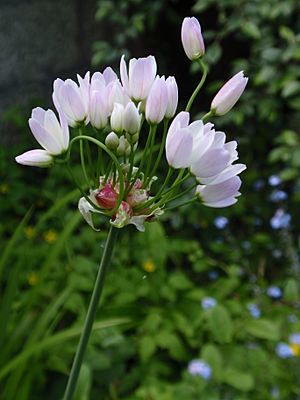Rosy garlic facts for kids
Quick facts for kids Rosy garlic |
|
|---|---|
 |
|
| Inflorescence of Allium roseum, blooming in Brest, France | |
| Scientific classification | |
| Synonyms | |
|
Allium roseum, also known as rosy garlic, is a type of wild garlic that you can eat. It comes from the Mediterranean area and nearby places. You can find it growing naturally from Portugal and Morocco all the way to Turkey and the Palestine region. People also grow it in many other parts of the world. It has even started growing on its own in some new places.
What Rosy Garlic Looks Like
Rosy garlic plants can grow to be about 45 cm (18 inches) tall. They like to grow in soil that drains water well. In Europe, these plants usually bloom, or flower, from late spring to early summer.
The flowers of rosy garlic grow in a cluster called an umbel. Each flower is loose and smells nice. They are about 3 inches long and have six petals that are pink or light purple.
The bulb of the rosy garlic plant has a very strong smell and taste. This strong smell can help keep animals like squirrels and deer away from gardens. Because of this, people often plant rosy garlic next to other flowers, like tulips. This helps protect the tulips from hungry animals.
How Rosy Garlic is Named
The scientific name Allium roseum was first given by a famous scientist named Carl Linnaeus. He wrote about it in his book Species Plantarum in 1753.
Scientists group plants into different types. For rosy garlic, there are a few accepted types:
- Allium roseum subsp. gulekense - found in Turkey
- Allium roseum subsp. roseum - found in most places where rosy garlic grows
- Allium roseum var. roseum - also found in most places where rosy garlic grows
- Allium roseum var. tourneuxii - found in Israel, Palestine, Egypt, Libya, Tunisia, and Algeria
See also
 In Spanish: Ajo de culebra para niños
In Spanish: Ajo de culebra para niños

